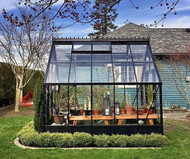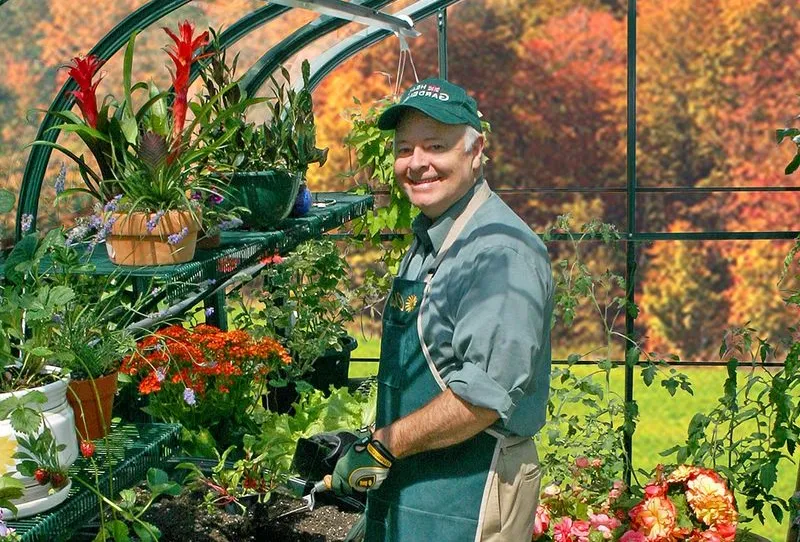Best Greenhouse Heaters for the Cold Season
Greenhouses are the perfect way to keep your kitchen stocked with fresh fruit and veg year-round; however, when it comes to making sure your hot house runs smoothly every season, you need the right climate control solutions.
In winter, when there is less sunlight, and the temperatures can reach below zero, greenhouse heaters are indispensable for maintaining the ideal interior temperatures. The right heater protects your plants from frost damage and extends the growing season, ensuring a continuous harvest even during chilly spells.
But which model is right for your greenhouse setup and climate? Explore some of the best greenhouse heaters available at Charley’s to find a suitable unit to promote healthy plant growth during the cold season.
The Importance of Greenhouse Heaters in the Cold Season
Heaters are essential during the cold season, helping regulate your greenhouse’s internal temperatures as external conditions approach or dip below freezing. Maintaining optimal temperatures is critical for fostering healthy plant growth and preventing damage like defoliation or wilting.
Different plant varieties thrive within specific temperature ranges, with most common greenhouse plants thriving in an average daily temperature of 60-75°F. Temperatures dropping below 30-54°F can impede this growth and damage cells and tissue, particularly in cold-sensitive plants like annual flowers, tomatoes, and citrus trees.
Heaters provide an effective preventive measure against harmful frost formation within the greenhouse, safeguarding sensitive flowers, fruits, and vegetables from withering, dieback, and blackened leaves. It also ensures consistently warm conditions for proper bloom setting and fruit maturation.
Greenhouse heaters also offer other benefits, including preventing irrigation lines from freezing and creating comfortable working conditions during winter. Choosing the right heater allows you to cultivate delicate plants year-round that would otherwise die in winter’s freezing temperatures.
Types of Greenhouse Heaters
When selecting a winter greenhouse heater, there are two main choices: electric or gas/propane models. You should choose a heater model based on the size of your greenhouse and your specific climate.
Electric Greenhouse Heaters
Electric heaters are favored for their safety, cleanliness, and user-friendly features. Equipped with built-in thermostats, they ensure precise temperature control, and multiple units can establish separate heated zones for optimal efficiency. There are various types of electric heaters, including:
-
Fan-forced heaters. These models use blowers to circulate warm air throughout the greenhouse space efficiently.
-
Ceramic heaters. Ceramic heaters feature enclosed heating elements for targeted infrared zone heating.
-
Radiant heaters. Mounted overhead, these heaters radiate warmth downward, leaving upper areas cooler.
Gas Greenhouse Heaters
Gas heaters offer enhanced heating capacity for larger commercial greenhouses and regions with colder climates. The choice between propane and natural gas will depend on your installation preferences. Gas heaters provide several advantages:
-
High BTU output. Ideal for heating expansive growing areas.
-
Clean, odorless heat. Blue flame burners ensure a comfortable and safe environment.
-
Reflective panels. They can direct warmth precisely where it's needed.
Gas heaters often boast lower operating costs compared to their electric counterparts. However, your greenhouse must have proper ventilation and clearance for combustion gases.
How to Calculate the Right Size Greenhouse Heater
To calculate the size of the heater you need for your greenhouse, consider several factors, including the greenhouse’s square footage, the desired temperature increase, insulation quality, and the external climate. Use the following step-by-step guide to help you determine the appropriate heater size:
-
Calculate the volume of your greenhouse. Find the volume of your greenhouse by multiplying its length, width, and height. For example, if your greenhouse is 10 feet long, 8 feet wide, and 10 feet high, its volume would be 800 cubic feet (10 x 8 x 10).
-
Determine the desired temperature rise. Decide how many degrees Fahrenheit you need to increase the temperature inside your greenhouse. For instance, if you want to raise the temperature from 32°F to 70°F, your desired temperature rise is 38 degrees.
-
Consider the insulation quality. The insulation quality of your greenhouse affects how much heat is retained. A well-insulated greenhouse requires fewer BTUs (British Thermal Units) per square foot than a poorly insulated one.
-
Account for the external climate. If your greenhouse is in a region with frigid winters, you’ll need a more powerful heater than a greenhouse in a milder climate.
-
Use a BTU calculator. Convert your requirements into BTUs (British Thermal Units), a standard heat unit. Many online BTU calculators can help with this.
Input the volume of your greenhouse, desired temperature rise, and insulation quality. The calculator will estimate the number of BTUs required to heat your space. If you choose a gas heater, its output is rated in BTUs so that you can select the model closest to the number of BTUs calculated for your space.
-
Convert BTUs to Watts. Electric heaters are typically rated in watts (although some models may also have a BTU rating). To convert BTUs to watts, use the formula: 1 watt = 3.41 BTUs. So, if your calculation requires 10,000 BTUs, you’ll need a heater that provides about 2,933 watts.
-
Consider heater efficiency. Remember that not all heaters are 100% efficient. Check the efficiency rating of the heater and adjust accordingly. For example, if a heater is 80% efficient, you’ll need a higher wattage to achieve the same heating effect.
Top Greenhouse Heaters for the Cold Season
Because of the vast range of greenhouse heaters available, deciding on the best brand and model for your space can be challenging. At Charley’s Greenhouse & Garden, we offer a range of electric and gas-powered greenhouse heater solutions tailored to your needs with options like:
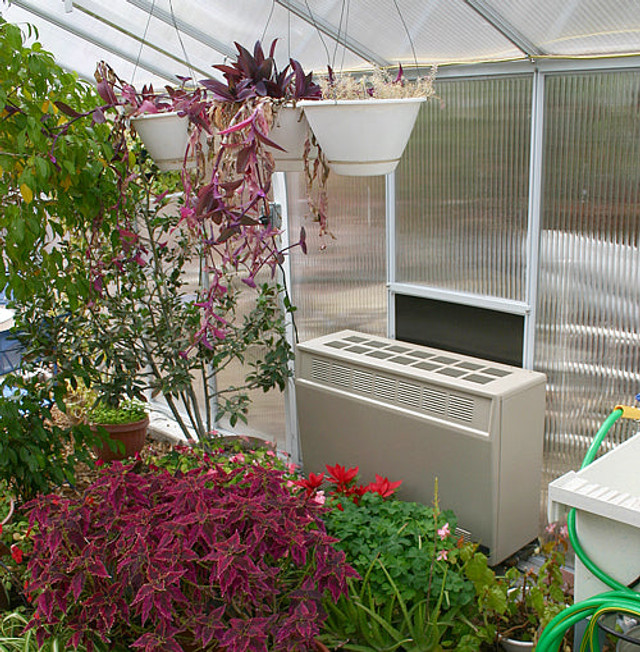
Direct Vent Empire Gas Heater
The Empire Direct Vent Gas Heater is a powerful yet discreet heating solution for greenhouses and conservatories. This wall-mounted propane unit ingeniously draws in outside air for combustion while efficiently venting exhaust gasses directly outside.
Its operation remains unaffected even during long power outages, making it a reliable backup option with efficient features like:
-
An impressive 30,000 BTU heating capacity for spaces spanning 500-1,200 square feet
-
Effortless piezo pilot ignition with a push button for your convenience
-
Space-saving low-profile design of just 12” depth
-
Remote thermostat for precise temperature control within the 40°F to 90°F range
-
Specially designed orifice burner ensuring quiet operation
-
A 100% safety shutoff system and dual valves for optimized gas and air mix

Rugged 120-Volt Portable Heater
The rugged 120-Volt Portable Heater is an excellent choice for versatile and targeted spot heating. This electric fan-forced heater, constructed with durable housing, boasts a 5,100 BTU heating capacity, making it an ideal supplemental warmer for smaller greenhouses. The portable heater also comes with:
-
Customizable thermostat with a range from 50°F to 90°F
-
Long-lasting stainless steel heating element
-
Maintenance-free operation with a permanently lubricated fan motor
-
Adjustable tilt angles for precise heat direction
-
Enhanced safety features, including overheating protection and a safety grill
-
Easy repositioning with a 6-foot cord and plug
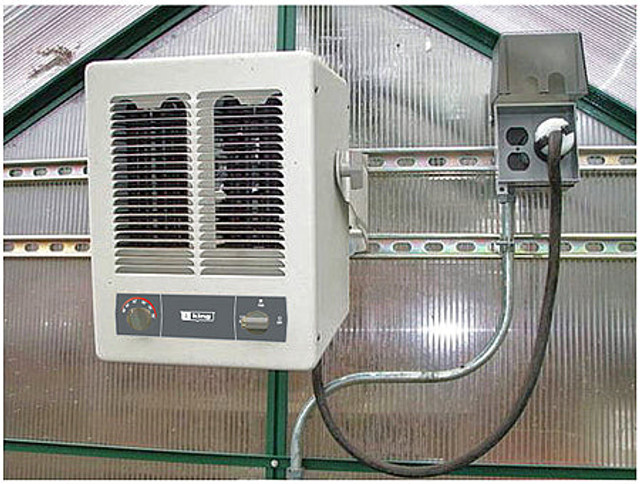
Super Heater 240-Volt
The Super Heater 240-volt electric model is a heavy-duty heating powerhouse designed for large commercial greenhouses. With a BTU output of 19,453 and an adjustable thermostat ranging from 40°F to 90°F, this heater ensures customized temperature maintenance. Its standout features include:
-
The highest BTU output among portable greenhouse heaters
-
A universal mounting bracket for flexible installation on the floor, wall, or ceiling
-
A capillary thermostat technology that resists greenhouse humidity issues
-
A sealed fan motor and auto-reset thermal limit control to ensure safety
-
Durable steel heating fins and cabinet with powder coating
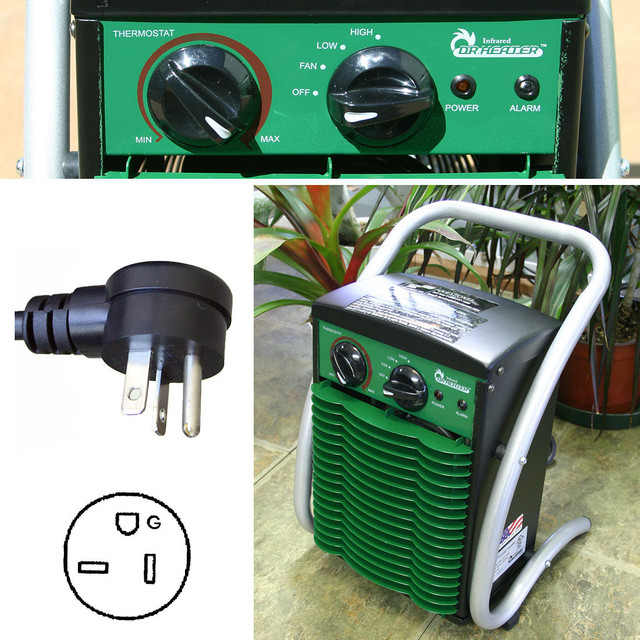
Charley’s 240-Volt Greenhouse Heater
Charley’s 240-volt electric heater is specifically designed for reliable and efficient performance within greenhouse environments. With an impressive 22,500 BTU output, this heater offers substantial heating capacity with advantages like:
-
Hydraulic thermostat with an exterior sensor enabling precise temperature control
-
Heavy-duty coil heating element and powder-coated steel casing ensure durability
-
Enclosed fan motor and water-shedding cabinet to resist moisture-related issues.
-
A high 30-foot fan circulation range
-
The thermostat ranges from 32°F to 104°F
-
Alarm indicator light signaling overheating
Tips for Using Greenhouse Heaters
Creating an optimal growing environment during winter requires effective installation, operation, and maintenance of your greenhouse heater. Follow these guidelines to ensure the optimal performance of your heating system.
Proper Installation
Follow the manufacturer’s instructions closely to ensure proper clearances, ventilation, gas lines, and safety accessories. Choose a centralized location in the greenhouse for even heat distribution. Maintain clearances and mount gas-fired units on non-combustible surfaces like concrete.
Propane heaters require a 10-foot clearance to burnable building materials. Keep a 2-foot clearance from plastic or polycarbonate glazing for gas and electric heaters. Set portable electric heaters on non-flammable surfaces away from water sources.
Ensure compliance with applicable codes for the original heater listing. Establish adequate ventilation and install high-limit switches and thermostats with remote sensors for automated temperature control.
Maintaining Optimum Temperature
Consistently monitor temperatures using a calibrated thermometer. Position sensors at different levels in multiple zones to identify and address temperature fluctuations. Set programmable thermostats to regulate systems automatically, creating optimal daytime and nighttime temperatures.
Balance heating with airflow fans and appropriately sized vents for ventilation. Ventilate on sunny winter days to prevent excess heat buildup. Use portable electric heaters diligently, moving them to direct warmth only where needed, and never leave them unattended.
Energy Efficiency
To maximize efficiency, conduct regular maintenance, clean heating equipment often, and address corrosion or damage promptly. Apply insulation to the walls, foundation, and ceiling of the northern wall, achieving an R-value of around 10, and ensure that you seal any cracks or gaps.
Set programmable thermostats conservatively and use insulated blankets between plant rows (and over the outside of the greenhouse if it is small enough) at night to retain warmth. Lower night temperatures in unused areas and minimize the use of standard overhead ventilation fans.
Manage environmental systems using historical weather data to optimize conditions while conserving energy. Keep records of heater runtime and temperature fluctuations to enhance efficiency.
Efficient Air Circulation
Promote effective air circulation within the greenhouse by strategically placing heat saver fans to disperse heat evenly. Position fans near the ceiling to disperse warm air downward, preventing temperature stratification.
This ensures that the entire plant area receives adequate warmth. Use oscillating or adjustable fans to maintain consistent airflow. Regularly clean and maintain fans to maximize efficiency, contributing to an environment conducive to their growth.
Promote even heat distribution and prevent heat loss by strategically placing fans, fostering an atmosphere supporting their well-being during winter.
Things to Consider When Choosing a Greenhouse Heater
In addition to calculating the size of your greenhouse, there are several other essential factors to consider when choosing the optimal greenhouse heater, including insulation, plant types, climate, and budget.
-
Types of plants being grown. Tailor your heating approach based on the types of plants in your greenhouse. Consider whether you’re cultivating tropical or temperate plants and using hydroponic or in-ground methods.
Adjust heating for specific plant needs. For example, tropical plants may require a minimum of 50°F. Review the optimal day/night temperatures, humidity, and ventilation requirements for your specific crops.
Programmable thermostats allow you to customize the environment precisely for your plants’ needs. Select small portable systems for localized heating of plant zones versus the entire greenhouse.
-
Climate and weather. Consider your climate zone, typical winter lows, and weather variability. Colder regions need more powerful heaters, sometimes with backup units for extreme lows.
Greenhouses in highly variable climates can also benefit from multiple program thermostats to handle fluctuations. If you live in a region that experiences frequent power outages, invest in a gas-powered heater that doesn’t need to be hooked up to mains power. Or, consider buying a generator to power your electric heater if the power goes down.
- Budget and operating costs. Assess the financial aspects, weighing initial investment against long-term expenses. Electric heaters may have lower upfront costs, but their operational efficiency and energy consumption should be considered.
Gas heaters, while potentially more expensive initially, might offer cost-effective long-term operation. Evaluate the availability and pricing of the chosen fuel source in your location.
Support Plant Growth During the Colder Months
Ensure that your plants not only survive but thrive this winter with Charley’s Greenhouse & Garden. As you prepare for the colder months, our range of the best greenhouse heaters will be your greenhouse’s biggest asset.
From precise electric heaters to powerful gas options, discover solutions designed to create the optimal environment for your plants. Explore our collection today for high-quality heating solutions and all your greenhouse needs.

